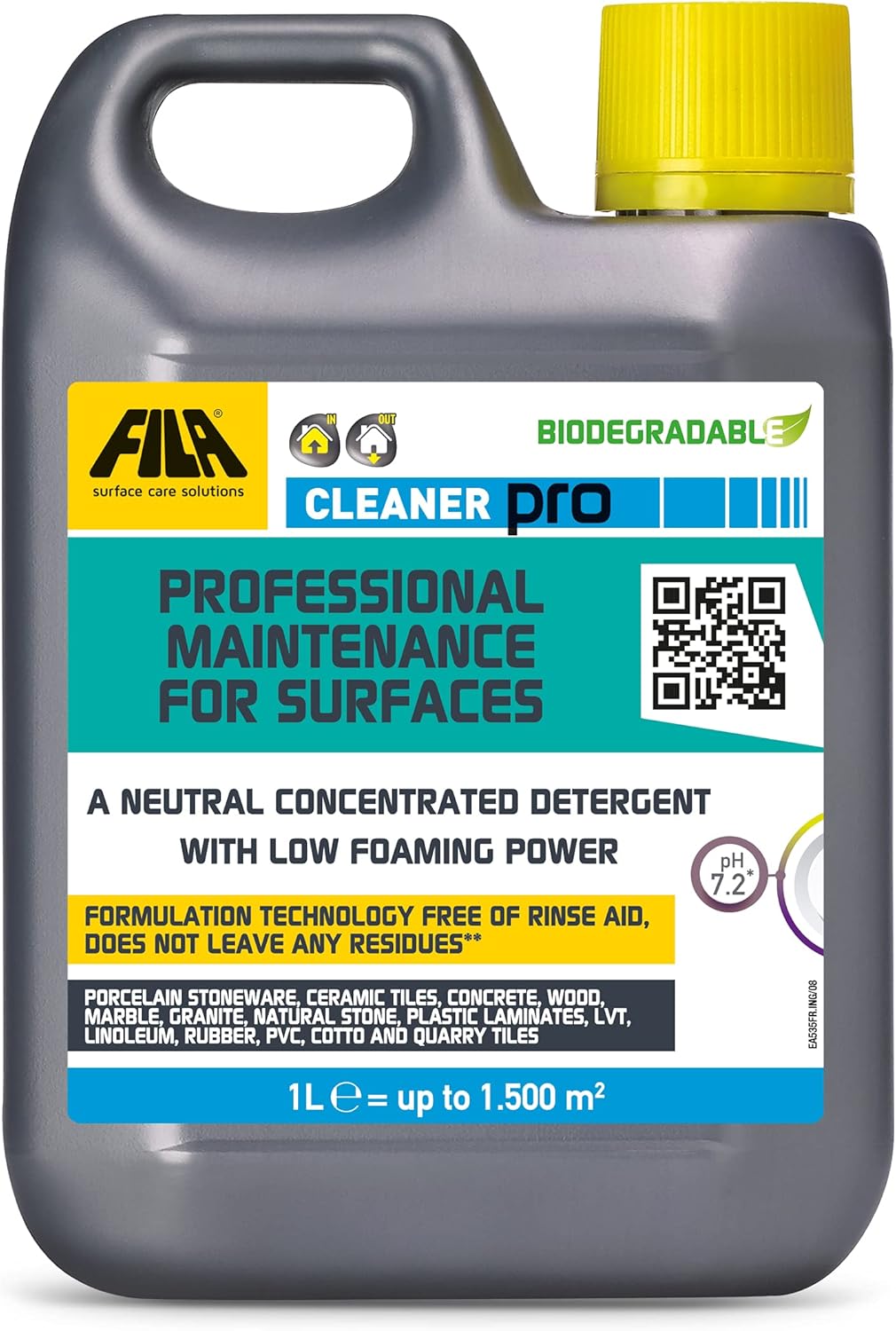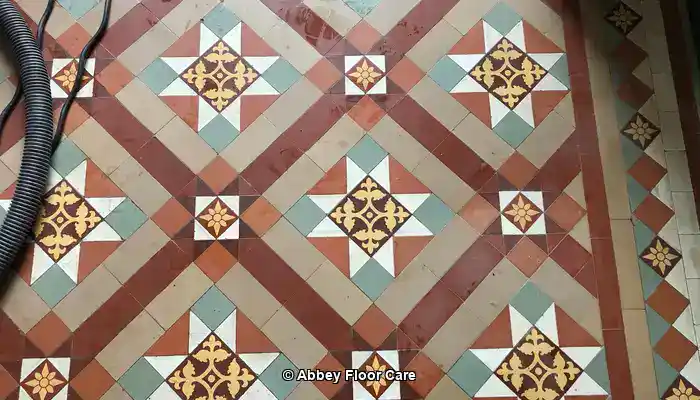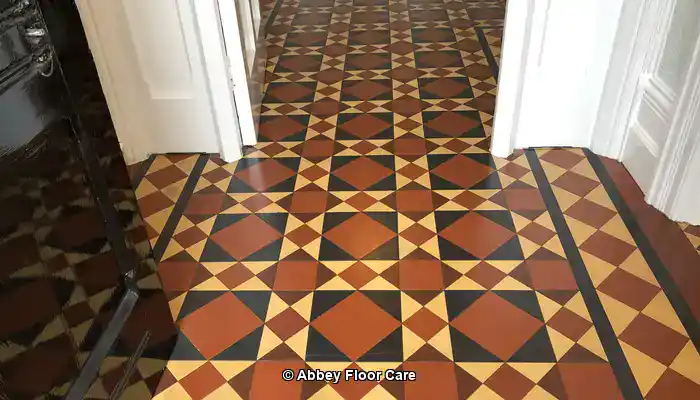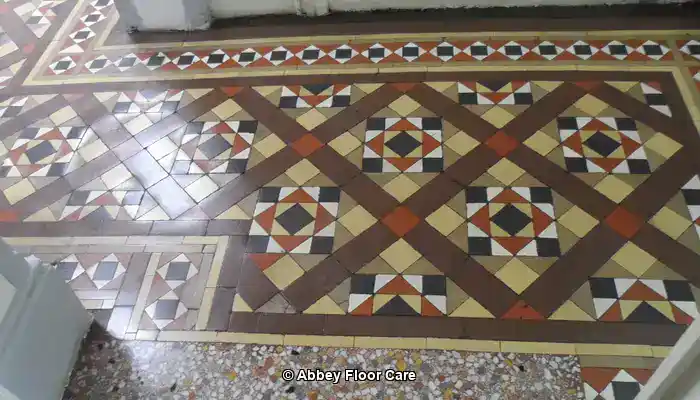
Last Updated on October 30, 2025 by David
Key Factors to Consider for Effective Restoration of Faded Victorian Mosaic Tiles
- Victorian mosaic tiles frequently undergo a significant loss of colour due to layers of dirt accumulation, outdated protective coatings, and general surface wear rather than simple aging. This loss can severely impact their visual appeal. To preserve their beauty and historical value, regular maintenance and professional restoration are essential to keep them looking their best.
- Harsh chemicals and aggressive cleaning techniques can inflict lasting damage on the original pigments, particularly on delicate encaustic and geometric tiles. Such methods can lead to irreversible harm, diminishing the tiles’ inherent beauty and character, which is why caution should be exercised during cleaning.
- Safe restoration starts with an intensive deep cleaning regimen that utilises pH-neutral solutions and low-speed rotary machines equipped with soft brushes. This approach ensures the delicate surfaces of the tiles are preserved and protected throughout the cleaning process.
- It is vital to carefully remove old sealers and waxes to reveal the true condition of the tile surface. This step is crucial for facilitating an effective restoration process that breathes new life into the tiles, allowing their original charm to shine through.
- Colour enhancement can be effectively achieved with breathable, stone-safe sealers that enrich the natural tones of the tiles without creating a glossy film. This method ensures the authentic appearance of the tiles is preserved while enhancing their visual appeal.
- Professional restoration techniques are indispensable for reviving the original pigments without resorting to painting or artificial colour applications, thereby ensuring the historical integrity of the tiles is both respected and maintained throughout the process.
- Ongoing maintenance for restored tiles requires a commitment to gentle cleaning practices, avoiding the use of acidic or bleach-based products that could compromise the surface integrity of the tiles over time.
- Heritage-sensitive methods are essential for maintaining both the aesthetic and historical significance of these remarkable tiles, ensuring they are cherished by future generations.
Learn Proven Techniques for Mastering the Art of Victorian Tile Restoration

Abbey Floor Care restoring the colour to a Victorian clay tile floor using a colour-enhancing impregnating sealer.
Victorian encaustic and mosaic tiles are an integral part of British architectural heritage, renowned for their intricate craftsmanship and vibrant colour palettes, which are the result of mineral pigments that are fused directly into the clay tile bodies. Unfortunately, these exquisite tiles often lose their visual appeal due to various factors such as surface wear, detrimental chemical interactions, and environmental influences over time. Successfully restoring their original vibrancy requires a specialised approach, combining a thorough understanding of the materials, historically accurate restoration techniques, and the use of high-quality products specifically formulated for tile restoration.
Pro Tip: Recommended Products for Daily Maintenance of Victorian Tiles

Fila Pro Floor Cleaner
|

LTP Colour Intensifier & Stainblock H20
|

Vileda H2PrO Spin Mop System
|
Over time, these stunning Victorian tiles often lose their visual charm due to factors such as surface wear, chemical degradation, and various environmental challenges. The restoration process, aimed at rejuvenating their original vibrancy, is complex and requires a specialist’s expertise. This process demands a deep understanding of the materials involved, a respect for the historical significance of the techniques used, and the application of high-quality products specifically designed for this delicate restoration work, ensuring that the tiles are treated with the utmost care and precision.
Identifying the Causes Behind the Fading and Dulling of Victorian Mosaic Tiles

Example of Victorian Clay Tile Floor dulled through surface wear and damage.
Even though the pigments are integral to the tile structure, a multitude of factors contribute to the fading and dulling of the tiles, leading to a significant loss of vibrancy and charm:
- Accumulated dirt and grime: Continuous foot traffic brings about the deposition of fine particles and oils that infiltrate the porous surfaces, scattering light and diminishing the original hues, which can significantly detract from the tiles’ aesthetic appeal.
- Wax and polish buildup: Layers of wax or sealants that lack breathability can trap moisture, resulting in a cloudy or yellowed appearance that obscures the tile’s natural beauty and diminishes its visual impact.
- Moisture-related issues: Many Victorian tiles were installed over subfloors without damp-proof membranes, leading to rising damp that introduces soluble salts. These salts crystallise on the tile surface as efflorescence, thereby obscuring the original tones and detracting from their overall appearance.
- Physical abrasion: Over time, small surface scratches accumulated from years of foot traffic disrupt the smooth reflection of light, resulting in a diminished visual richness and vibrancy of the tiles.
Effective restoration strategies must carefully address each of these contributors without compromising the historical makeup of the tiles, ensuring that the tiles regain their original vibrancy and aesthetic appeal, ultimately restoring their place as a beautiful feature in any space.
The Critical Role of Breathability in Victorian Tiles Without a Damp-Proof Membrane
Considering that many Victorian tiled floors are located on older subfloors that lack a damp-proof membrane (DPM), it is imperative that their natural clay structure remains permeable. This permeability enables effective evaporation of moisture that originates from the subfloor. Non-breathable wax coatings or film-forming sealers obstruct this crucial evaporation pathway, resulting in moisture accumulation beneath the tile surface. Such trapped moisture can lead to salts and humidity causing efflorescence, mineral degradation, and the unwanted white haze known as wax blooming, which significantly detracts from the tile’s aesthetic appeal. Restoration efforts must focus on implementing breathable impregnating sealers that protect the tiles while allowing moisture vapour to escape freely, thereby preventing long-term damage to these valuable surfaces and preserving their beauty.
In-Depth Examination of Pigments and Tile Composition in Victorian Mosaic Tiles

An example of different pigments in a Victorian Clay tile floor during restoration by Abbey Floor Care
Understanding the Significance of Mineral Oxide Pigments in Victorian Tiles
Victorian mosaic and encaustic tiles derive their distinctive earthy colours from mineral oxide pigments that are embedded directly into the clay. These pigments not only provide durability but also significantly enhance the depth of colour and richness. The primary pigments include:
- Iron oxide: This pigment is responsible for creating terracotta reds, rust browns, and soft ochres that impart warmth to the tiles, enriching their visual palette.
- Manganese: Contributing deep browns and rich blacks, manganese enhances the striking contrast found in various tile designs, adding to their overall appeal.
- Cobalt: This pigment lends varying blue hues, introducing cool tones that harmonise beautifully with the warmer shades present in the tiles.
- Chromium: Generating natural green shades, chromium offers a refreshing variety of colours to the tile palette, further enhancing their visual complexity.
Explaining the Firing and Fusion Process of Victorian Tiles
During the manufacturing process, the tiles are fired at temperatures around 1100°C, a critical step that vitrifies the clay and fuses the pigments deeply within the tile body. This technique ensures that the colour permeates throughout the tile rather than merely resting on the surface, resulting in long-lasting vibrancy that endures over time, making these tiles not only beautiful but also resilient.
Exploring the Characteristics of the Porous Unglazed Finish of Victorian Tiles
Victorian tiles typically exhibit a porous, unglazed matte finish that enhances their natural aesthetic appeal. However, this porosity makes the tiles more susceptible to absorption and surface contamination, necessitating meticulous cleaning and maintenance to uphold their integrity and beauty. Regular care is essential to prevent damage and preserve the tiles’ unique characteristics.
Understanding Colour Durability Variability Among Different Victorian Tiles
Natural earth pigments, particularly those used in red and yellow tiles, often contain fewer mineral additives than darker colours, which are usually formulated with manganese. This difference in composition suggests that red and yellow tiles are generally less durable and more prone to surface dishing under heavy foot traffic. Such wear manifests as shallow depressions in high-traffic areas, leading to uneven colour intensity and a noticeable loss of surface flatness, ultimately affecting the tiles’ overall appearance.
Key Considerations for the Effective Restoration of Victorian Tiles
A comprehensive understanding of pigment composition and tile wear patterns is crucial for successful restoration planning. Softer-toned tiles require gentler cleaning techniques and tailored impregnating sealers that respect their unique physical properties while enhancing colour. In contrast, darker, more resilient tiles can withstand more intensive cleaning procedures but still need breathable, colour-enhancing protection to maintain their vibrancy over time, ensuring their beauty lasts for generations.
Highly Effective Cleaning Techniques for Revitalising Victorian Mosaic Tiles
The restorative cleaning process is vital for rejuvenating Victorian encaustic and mosaic tiles to their original brilliance. However, the cleaning process necessitates a specialised approach that goes beyond the use of standard pH-neutral detergents typically recommended for everyday upkeep. Professional restorers utilise meticulously formulated alkaline cleaners in conjunction with mechanical techniques to effectively dismantle heavy soiling and old residues while ensuring the integrity of the historic tile fabric is preserved throughout the process.
Initial Debris Removal Techniques for Effective Tile Cleaning
The cleaning operation begins with the careful removal of all loose dirt and grit, typically accomplished using soft brushes or vacuuming with brush attachments. This initial step is crucial to prevent scratching the delicate tile surfaces during subsequent cleaning phases, ensuring that the restoration process maintains the tiles’ original aesthetic appeal and integrity.
Utilising Alkaline Cleaners for Comprehensive Soil Removal
In the realm of tile cleaning, alkaline cleaners are indispensable for breaking down ingrained fatty acids and organic soils that pH-neutral solutions often fail to adequately address. These alkaline formulations dissolve the binding agents of dirt, sugars, and fats, facilitating their efficient removal while remaining compatible with the mineral composition of Victorian tiles. Professional-grade alkaline products, such as PS87 PRO or custom formulations from heritage cleaning specialists, are typically used in diluted form to ensure effective deep cleaning without excessive aggression towards the clay body. It is essential to bear in mind that even when using alkaline cleaners, caution is paramount, and spot testing is always advised to ensure compatibility and prevent any unintentional damage.
Enhancing Cleaning Efficiency with Mechanical Agitation Techniques
The inclusion of mechanical action significantly enhances the effectiveness of the cleaning process. Low-speed rotary scrubbers fitted with red or, on occasion, green non-abrasive pads are commonly used to agitate soils from small pits, tile surfaces, and grout lines. These pads clean thoroughly while safeguarding the integrity of tile edges and delicate surface details, thereby preserving the tiles’ authenticity and visual integrity throughout the cleaning process.
Removing Waxes and Exotic Sealants for Optimal Tile Restoration
Over the years, the accumulation of old waxes and sealants—often resulting from DIY attempts using inappropriate products—can present significant challenges to elimination. Water-based cleaners, whether alkaline or mildly acidic, are preferred for effectively stripping these residues without damaging the mineral structure of the tiles. However, stubborn ‘exotic’ or solvent-resistant coatings may necessitate targeted solvent-based removers such as <em>Lithofin Wax-Off</em> or LTP Solvex. These solvents can effectively soften and emulsify waxes and old sealants but must be handled with care by professionals trained in their safe application and disposal processes to ensure effective results without compromising the tiles.
Implementing Comprehensive Rinsing and Drying Procedures
Following the chemical cleaning process, comprehensive rinsing is essential to eliminate all traces of cleaning residues. Multiple rinses with clean water, coupled with wet vacuum extraction, ensure that no detergent or solvent remnants remain that could interfere with subsequent restoration coatings. The drying time may vary based on environmental conditions, such as humidity, surface type, and moisture content. Restoration specialists consistently utilise moisture metres to verify that the tiles are entirely dry before applying any impregnating sealers or protective treatments. This meticulous approach prevents moisture entrapment, which could otherwise lead to efflorescence, staining, or damage beneath sealed layers, ensuring the longevity and beauty of the restored tiles.
The Advantages of Thorough Cleaning for Successful Tile Restoration
Thorough cleaning is paramount in revealing the actual condition of the tiles by removing visual obstructions. This process uncovers areas that may require repair and provides a clean, receptive surface for colour-enhancing impregnators or other restorative products. Such careful preparation is fundamental to the success and longevity of Victorian mosaic tile restoration, allowing the tiles to shine once more.
Enhancing Colour with Premium Impregnating Sealers
Restoration specialists employ premium colour-enhancing impregnating sealers produced by renowned brands such as LTP and Lithofin, celebrated for their advanced, heritage-approved formulations. Unlike superficial coatings, these sealers:
- Penetrate deeply into tile pores to enrich colour physically by altering light refraction for a more vibrant appearance, enhancing the overall look of the tiles.
- Maintain vapour permeability, which is essential for moisture escape and is particularly critical in older floors lacking DPM layers, thus preventing long-term damage.
- Offer durable protection against stains and foot traffic without altering the natural texture or gloss of the tiles, ensuring they remain true to their original charm.
- They are applied in multiple light coats, with each coat allowed to penetrate before the next is applied to ensure complete uniformity and efficacy, enabling a more effective restoration process.
These sealers directly address the fading of Victorian tiles by restoring vibrancy while preserving the breathable nature of the historical flooring, ensuring their beauty lasts for years to come.
Repairing Damaged Tiles and Applying Colour Tinting Techniques
Tiles that exhibit chips, cracks, or missing segments require careful repair using tinted epoxy or lime-based mortars, colour-matched with natural mineral oxides to ensure aesthetic continuity. Restoration experts often source matching replacement tiles from salvage archives to maintain pattern consistency and authenticity. Colour tinting involves the selective application of earth-pigment-infused wax or resin mixtures to delicately blend in worn or missing pattern areas while also respecting tile breathability and reversibility for future restoration efforts, ensuring the tiles remain true to their original design.
Best Practices for Effective Colour Tinting of Tiles
- Utilise small, controlled applications to avoid excessive colouring that could detract from the tile’s authenticity and visual coherence, ensuring a seamless integration.
- Conduct patch testing on inconspicuous areas before complete application to ensure compatibility and aesthetic continuity with existing tiles, thereby preventing any unwanted mismatches.
- Ensure compatibility with the impregnating sealers used on the entire surface for a seamless finish that enhances the visual coherence of the restored tiles, allowing for a beautiful, cohesive look.
Essential Ongoing Maintenance Strategies for Restored Victorian Mosaic Floors
Preserving the restored colour and condition of Victorian mosaic tiles necessitates diligent and ongoing care:
- Routine cleaning should be conducted using pH-neutral, non-abrasive detergents specifically formulated for historic tiles to avoid any potential damage and ensure their longevity.
- Preventive measures, such as placing entrance mats, can significantly minimise dirt ingress and protect the tile surfaces from wear, extending their overall lifespan.
- Liquid spills, especially acidic substances like vinegar or wine, should be promptly cleaned to prevent surface etching and damage, safeguarding the tiles’ appearance.
- Breathable impregnating sealers should be reapplied every 3–5 years or as wear indicates to maintain optimal protection and aesthetic integrity, ensuring the tiles look their best for years to come.
- Regular monitoring of floors for signs of efflorescence or moisture ingress is crucial to address any underlying damp issues before they escalate, preserving the tiles’ beauty and functionality.
Avoiding Common Pitfalls in the Restoration Process
- Avoid wax treatments that can obstruct breathability, leading to efflorescence or the undesirable wax blooming effect, which can detract from the tiles’ appearance.
- Do not use acrylic or polyurethane sealants, as they can trap moisture and contribute to degradation of the tiles over time, compromising their structural integrity.
- Limit the use of harsh chemical cleaners, as they can erode both the clay and pigments, ultimately compromising the tiles’ beauty and longevity.
- Never repaint tiles; paint films alter their visual and physical properties and are not reversible, thus damaging the tile’s historical value and authenticity.
- Recognise and address any underlying issues with older subfloors before sealing to ensure the longevity and success of the restoration work, preventing future complications.
Showcasing Successful Restoration Projects in the Field
Examples of successful restoration projects illustrate the effective application of these principles:
Revitalising a Victorian Hallway in Sheffield

Our cleaning procedure effectively eliminated years of wax and grime, followed by the application of a Lantania Avo colour-enhancing impregnating sealer, which visibly enriched the tile colours. This was subsequently complemented by the application of an acrylic topical sealer to provide surface protection for floors installed over a damp-proof membrane, ensuring long-lasting beauty and durability.
Restoring a Civic Mosaic Floor in Chesterfield

After thorough cleaning and the removal of old topical sealers, the floor was sealed using an LTP Colour Enhancing Impregnating sealer. The surface was then further protected with wax, carefully applied to seamlessly integrate the clay tiles into the historic fabric of the building, ensuring they remain a beautiful feature for generations to come.
Preserving Heritage Through Expert Restoration Practices
Restoring the colour and pigment of Victorian mosaic tiles is a complex undertaking that requires a delicate balance between material science, craftsmanship, and a profound sensitivity to heritage values. By utilising premium impregnating colour-enhancing sealers from industry leaders such as Dry Treat, Lantania, and Lithofin, professionals ensure long-term breathability, protection, and vibrancy of colour. Skilled cleaning, meticulous repair, and dedicated maintenance are essential to preserving authenticity while rejuvenating these historic floors for future generations to appreciate and enjoy.
Frequently Asked Questions About Victorian Mosaic Tile Restoration
What characteristics define Victorian mosaic tiles?
Victorian mosaic tiles are decorative tiles that gained popularity in the 19th century, revered for their vibrant colours and intricate patterns. These tiles were commonly used in public buildings and private residences, adding an artistic flair and historical significance to various spaces.
How can I effectively restore faded Victorian mosaic tiles?
Restoring faded Victorian mosaic tiles involves a comprehensive process that includes detailed cleaning, repairing damages, applying new pigments to match the original colours, and finally sealing the tiles to protect them from future wear and tear, ensuring their beauty is preserved.
What materials are essential for the restoration of tiles?
Key materials for effective tile restoration encompass specialised cleaning solutions, pigments, adhesives, grout, and protective sealants, all selected for their compatibility with the original tiles to ensure a seamless and effective restoration process.
How long is the tile restoration process expected to take?
The duration of tile restoration can vary significantly based on the size and condition of the area being restored, typically ranging from a few days for smaller projects to several weeks for larger restorations that require more intricate work and attention to detail.
Can I undertake the restoration process independently?
Yes, smaller restoration projects can be approached as DIY tasks if you possess the necessary skills and tools. However, more complex repairs necessitate professional expertise to ensure quality results and protect the integrity of the tiles, maintaining their historical value.
What is the financial investment associated with restoring Victorian mosaic tiles?
The costs for restoring Victorian mosaic tiles can vary widely based on project size and condition, ranging from several hundred to thousands of pounds for comprehensive restorations, depending on the extent of the work required and the materials used.
How do I select the right restoration expert for my project?
When choosing a restoration professional, look for those with a proven track record in historical projects, positive reviews, and a commitment to employing authentic materials and techniques that respect the integrity of your tiles, ensuring quality workmanship.
What challenges do restorers typically face during the restoration process?
Restorers often encounter challenges such as matching original colours, repairing damaged tiles, and ensuring the longevity of the restoration efforts, particularly in the context of preserving historical significance and maintaining the tiles’ integrity.
How can I maintain restored tiles effectively?
Maintaining restored tiles involves regular cleaning with pH-neutral products, avoiding harsh chemicals, periodically resealing, and promptly addressing any damage to ensure the tiles retain their beauty and durability throughout their service life, safeguarding their historical value.
What innovations are currently influencing tile restoration techniques?
Recent advancements in tile restoration techniques include the development of advanced cleaning solutions, innovative types of sealants, and the application of digital technology for precise colour matching and pattern replication in restoration projects, enhancing the overall effectiveness of the restoration process.
The Article Restoring Colour and Pigment to Faded Victorian Mosaic Tiles was first found on https://www.abbeyfloorcare.co.uk
The Article Restoring Faded Victorian Mosaic Tiles’ Colour and Pigment appeared first on https://fabritec.org
The Article Restoring Colour and Pigment in Faded Victorian Mosaic Tiles Was Found On https://limitsofstrategy.com
References:
Restoring Colour and Pigment in Faded Victorian Mosaic Tiles



